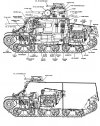I thought some of the (intact) Bs had headed east with the S35s.The Matilda II chassis is a bit of a mismatch regarding weight, complexity and mobility, with a splinters-and-bullets-only shield atop. Plus, having only one or two such chassis, anything you develop has a relatively large engineering and mechanic/armorer investment per combat unit produced. And, it'd be too few units to justify tooling up spare parts, so maintenance and repairs would be difficult at best.
Much better to use something of which you have much greater numbers...as Becker did with the Jagdpanzers.
OTL, there were quite a few Universal Carriers captured, along with a fair number of Lorraine 37/38 (already grabbed by Becker). Nothing else from 1940 was a good candidate--the Hotchkiss 35/39 chassis was a poor design for such conversions, being underpowered and unreliable. The Renault 35/40 was underpowered and, suspension-wise, not capable of much speed. The B tanks were way obsolete in regard to some of their mechanics, and way over-complicated in others, plus they were just too tall. The S tanks were the best candidates for gut-and-rebuild conversion, but their turrets and hull openings were too small for simple re-gunning as a tank.
You are using an out of date browser. It may not display this or other websites correctly.
You should upgrade or use an alternative browser.
You should upgrade or use an alternative browser.
Alternative History Armoured Fighting Vehicles Part 4
- Thread starter Claymore
- Start date
Many of the S tanks went to the Balkans or to the Western Wall, but yes, the Germans did use whatever B tanks they could get running, and mostly on the eastern front. A number were converted to flamethrower tanks...I think, per the practical assumption that those weapons would have a short life anyway due to being a highest-priority target for Russian defenders, so why not use something clunky and not very survivable anyway, as armor expectations rapidly advanced? Then the more modern platforms could be used more effectively by, for instance, being sent to Major Becker to come back as very usefully upgunned jagdpanzers.
To add to that...The only early war French tank with enough room in the turret to fit the recoil of a German full-length 75mm gun would have been the not-ready-for-prime-time G1R.
Matilda wouldn't fit a six pounder, let alone a 75mm.
I recently revisited the question of turret ring diameters because the commonly-quoted French figures actually have subtle points behind them.
It turns out that when the French cite the turret ring diameter ("diamètre du chemin de roulement"), they really mean the diameter up to the middle of the ball bearings of the turret ring mechanism. This means that the actual "free" inside diameter you have to get you feet and ammo through is a bit smaller due to the rest of the mechanism, a few dozen mm to 200mm depending on the size of the mechanism (partially dependent on the size of the ring itself). Most of the French multi-man 75mm turrets also had some sloped walls and small bustles, like most turrets of the time. This value was mistaken for the diameter of the hull roof opening for the turret and turret ring in the G1 tanks, which is 1790mm for ARL 3 (and apparently 1880mm for the diameter where they install the base of the turret, which extends a bit in front of the roof opening).
In the case of the ARL turrets envisionned for the G1, the turret ring diameter at the ball bearings, based on archives found at Vincennes, is 1670mm (ARL 3, 75mm gun) or 1650mm (ARL 1, 47mm long casemate gun. GBM claims 1520mm ring dia and 1440mm free diameter). Or 65.75 and 65 inches respectively. The free diameter was specified to be a minimum of 1450mm, so the real free space would have to sit between 1450 and 1670mm, likely in the 1500mm range. The ARL 4 turret which was also proposed for it and designed for early French fortification assault tank concepts with the 75mm gun had a claimed 1680mm (including ball bearings and "crown", so maybe a different measurement than the turret ring dia at the ball bearings), and a free space of 1480mm.
Note that both the ARL 3 and 4 are claimed to have 2 men inside (3: per a manual, though a Vincennes sheet on turrets claims 3, 4 per the historians writing the GBM magazine), while the ARL 1 had 3. The ARL 7 fortification assault tank turret had a 1900mm turret ring dia at the ball bearings, and a 2-man crew around a medium velocity 105mm or 90mm gun.
Note that this doesn't mean the turrets were too small to have 3 men. I think the reason most have 2 is because the French were overestimating the amount of space to give to each crew member or to equipment; and because, possibly, the French did not believe in the concept of the separate commander, as most turrets opt instead for a loader and a commander-gunner. This is, incidentally, probably why they did not think one-man turrets were bad because they already believed in the commander-gunner and they expected loading to be easy with the small caliber guns. Only the long 47 and bigger guns needed a dedicated loader. The ARL 1 is the sole known exception before 1940 with a rational 3-man turret crew.
For reference, the 1942 FCM turret studies (up to 3-man with long 47) were more progressive, so successfully packed all of this with reasonable room in a 1505mm turret ring dia at the ball bearings (1605mm roof opening, 1435mm free diameter accounting for the turret floors).
In any case, you see the FCM turret sits just between T-34-76 and Cromwell in terms of free diameter /turret ring dia; and the G1 turret offerings sit anywhere between the Cromwell's 57.2 inches and, likely, 1600mm or 63 inches. Note that Cromwell's turret ring dia at the ball bearings is 60 inches, so the French turrets are likely to be roomier. I'm not sure they would be directly capable of using a long 75mm gun, especially a KwK 40. It could be possible with the same turret ring, but the location of the trunions and the size of the bustle would have to be modified to increase space. Still close to Panzer 4 and better than most tanks introduced in 1941-42, with Sherman being the true outlier.
Last edited:
For a project wishing to mount a long 75mm gun in a mostly-existing 1940 French AFV, likely the best bet would be an S-tank-hull-based assault gun, similar to the S35-hull-based early SAu40 prototypes but perhaps without the very tall MG-turret. With substantial engineering already done, and one 75mm-armed and several 47mm-armed prototypes having been fielded in 1940, even a re-design that was to use a more powerful engine/transmission, a longer main gun and thicker frontal armor would be starting from a more advanced point.
Good points but wasn't the turret in the SAu mainly to house the rangefinder, with any mg capability a handy extra?For a project wishing to mount a long 75mm gun in a mostly-existing 1940 French AFV, likely the best bet would be an S-tank-hull-based assault gun, similar to the S35-hull-based early SAu40 prototypes but perhaps without the very tall MG-turret. With substantial engineering already done, and one 75mm-armed and several 47mm-armed prototypes having been fielded in 1940, even a re-design that was to use a more powerful engine/transmission, a longer main gun and thicker frontal armor would be starting from a more advanced point.
Perhaps I'm not the right person to address that question, because I had never heard of the SAu40 being equipped with an optical rangefinder...other than possibly a pair of rangefinding handheld binoculars.
But anyway:
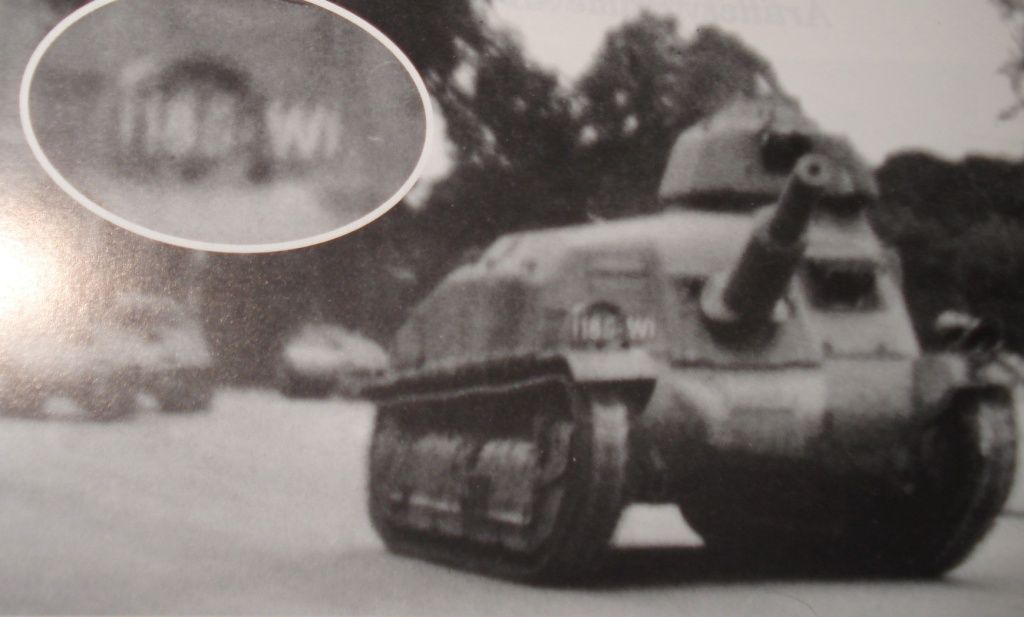
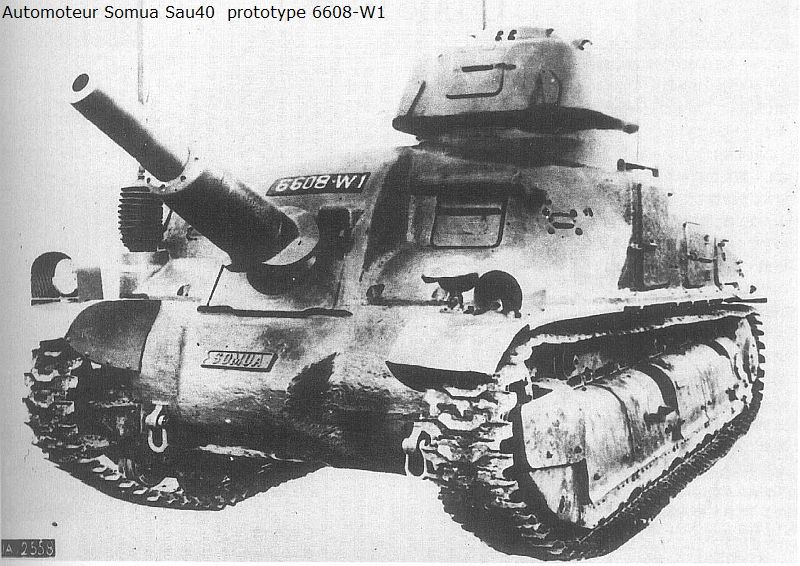
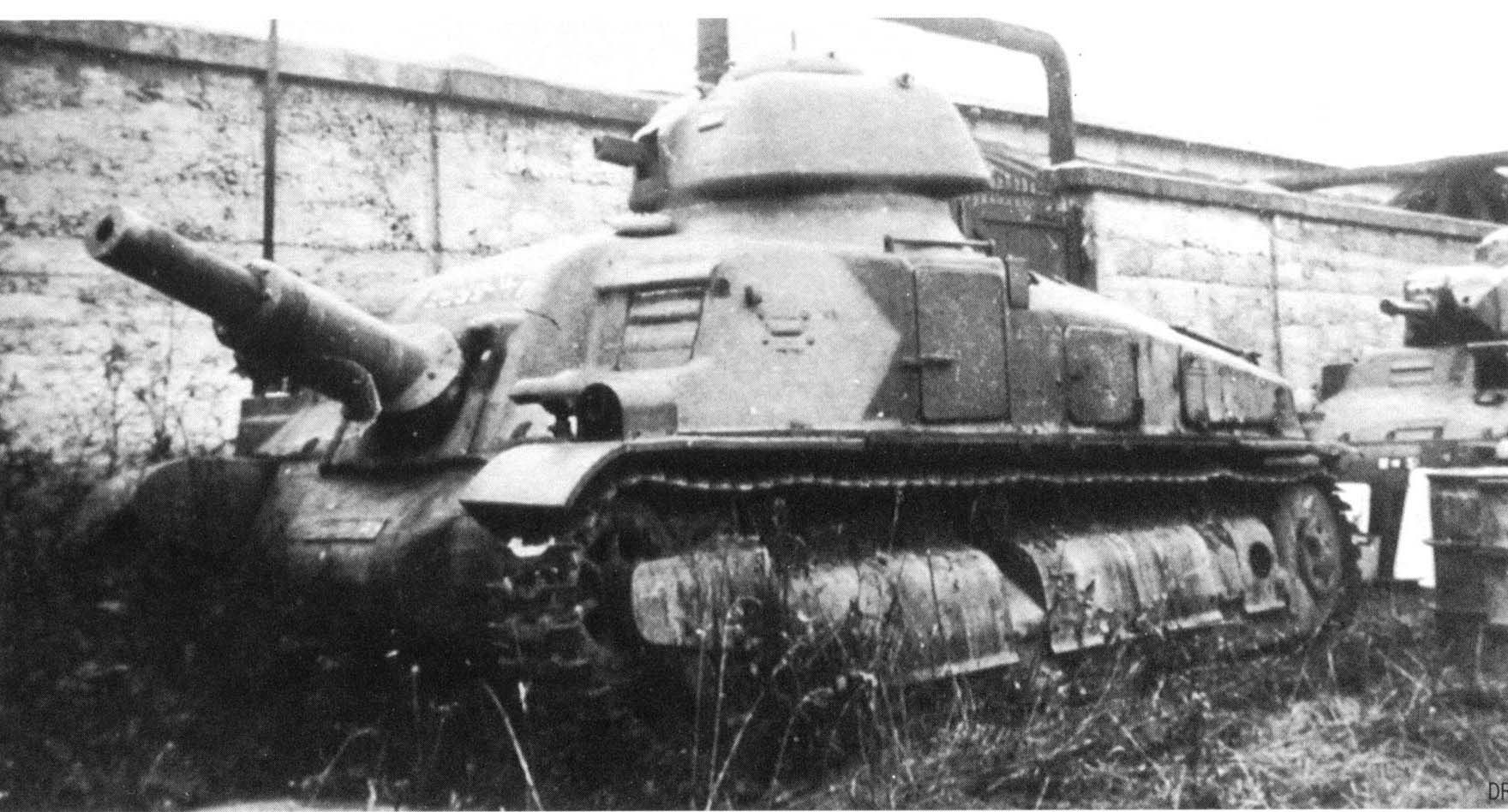
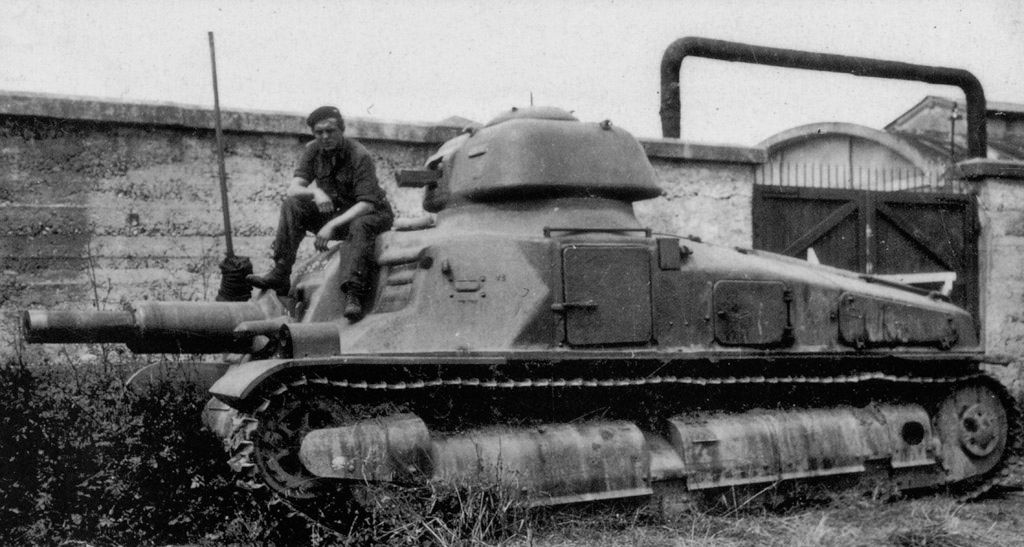
There are AFAIK no photographs of the intended production version of the SAu40 i.e. with the S40-based hull and the larger and more powerful engine, and perhaps the long 47mm gun; or of the small number (5 or 6?) of long-47mm-armed prototypes, and few photographs of the one 75mm armed prototype. The above photos have been said to be of that 75mm armed prototype while still at the factory or in development testing, but in the form that went to combat.
I don't see any indication of an optical rangefinder integrated into the MG turret on this prototype.
My understanding is that eventually the SAu40 was to be equipped with a new turret, and I don't know if that new turret would have had an integrated rangefinder. AFAIK no examples of that eventual turret were mounted to hulls.
I'd certainly be interested in evidence that my understanding is wrong, though.
But anyway:




There are AFAIK no photographs of the intended production version of the SAu40 i.e. with the S40-based hull and the larger and more powerful engine, and perhaps the long 47mm gun; or of the small number (5 or 6?) of long-47mm-armed prototypes, and few photographs of the one 75mm armed prototype. The above photos have been said to be of that 75mm armed prototype while still at the factory or in development testing, but in the form that went to combat.
I don't see any indication of an optical rangefinder integrated into the MG turret on this prototype.
My understanding is that eventually the SAu40 was to be equipped with a new turret, and I don't know if that new turret would have had an integrated rangefinder. AFAIK no examples of that eventual turret were mounted to hulls.
I'd certainly be interested in evidence that my understanding is wrong, though.
Last edited:
I might have mixed it up with the ARL 39.Perhaps I'm not the right person to address that question, because I had never heard of the SAu40 being equipped with an optical rangefinder...other than possibly a pair of rangefinding handheld binoculars.
But anyway:




There are AFAIK no photographs of the intended production version of the SAu40 i.e. with the S40-based hull and the larger and more powerful engine, and perhaps the long 47mm gun; or of the small number (5 or 6?) of long-47mm-armed prototypes, and few photographs of the one 75mm armed prototype. The above photos have been said to be of that 75mm armed prototype while still at the factory or in development testing, but in the form that went to combat.
I don't see any indication of an optical rangefinder integrated into the MG turret on this prototype.
My understanding is that eventually the SAu40 was to be equipped with a new turret, and I don't know if that new turret would have had an integrated rangefinder. AFAIK no examples of that eventual turret were mounted to hulls.
I'd certainly be interested in evidence that my understanding is wrong, though.
It's referenced in passing in Wikipedia, but I have previously found more robust sources. Unfortunately that was about 2012, so finding it may be impractical, as I have had at least three replacement PCs since then and my filing system would embarrass a squirrel's record of where the nuts are buried.
T
The SAu 40 prototype already incorporated thd S40-style suspension with raised idler, it wouldn't have changed much. The powerful engine was not part of SAu and S40's manufacturing programs but was a separate program which may be implemented immediately with the first production tanks of both types, or later during production.
The rangefinder openings are visible on the second picture, covered by armor plates. It's a small RF at the time.Perhaps I'm not the right person to address that question, because I had never heard of the SAu40 being equipped with an optical rangefinder...other than possibly a pair of rangefinding handheld binoculars.
But anyway:




There are AFAIK no photographs of the intended production version of the SAu40 i.e. with the S40-based hull and the larger and more powerful engine, and perhaps the long 47mm gun; or of the small number (5 or 6?) of long-47mm-armed prototypes, and few photographs of the one 75mm armed prototype. The above photos have been said to be of that 75mm armed prototype while still at the factory or in development testing, but in the form that went to combat.
I don't see any indication of an optical rangefinder integrated into the MG turret on this prototype.
My understanding is that eventually the SAu40 was to be equipped with a new turret, and I don't know if that new turret would have had an integrated rangefinder. AFAIK no examples of that eventual turret were mounted to hulls.
I'd certainly be interested in evidence that my understanding is wrong, though.
The SAu 40 prototype already incorporated thd S40-style suspension with raised idler, it wouldn't have changed much. The powerful engine was not part of SAu and S40's manufacturing programs but was a separate program which may be implemented immediately with the first production tanks of both types, or later during production.
My understanding is that the rangefinding-artillery-binoculars approach used on the sturmgeshutzen was entirely satisfactory when not ignored, being used only for direct-sighted artillery fire. Anti-tank fire was normally accomplished using the same range approximation methods that were an inherent part of gunner technique with AT gun and tank gun sights of the time.
Considering the overriding importance of not being spotted to combat effectiveness, the value of losing the height and visual prominence of that commander turret IMO would far outweigh any functionality it might have been intended to contribute.
Considering the overriding importance of not being spotted to combat effectiveness, the value of losing the height and visual prominence of that commander turret IMO would far outweigh any functionality it might have been intended to contribute.
Last edited:
Speaking of that...
My visit at Vincennes from last Saturday precisely unveiled some plans of Somua and ARL V 39 SPGs (non-final plans of the latter), and a technical manual for the latter. I will add more stuff during the week, namely a B1 Bis technical manual, plans of the Char BL (an early name of the B1 Ter) with letters about the B1 Bis/BL/Ter from 1935, and eventually the reports of the meetings of the French tank technical study committee between 1937 and 1939, which mostly delved into the technical aspects of the G1 tank program, R35 light tank upgrades and trials of a radio in a H35.
They are be stored in a part 2 of my google photos, of which I give a link and remind you of the link to the previous part.
https://photos.app.goo.gl/NtDxrFn1oysb8TDZ6
https://photos.app.goo.gl/5tnqr7DG7vhBrVRB9
They specify the tank has a periscopic binocular sight AND a 0.8m base stereoscopic rangefinder in the turret. The azimuth and elevation data are displayed for the two gunners (the driver can aim in azimuth and elevation, the radio-gunner only in elevation so both can split tasks as needed). Interestingly enough the tank apparently had an automatic loader, but I think they meant a rammer. To split tasks as much as possible there are two loaders, one to set fuzes and one to load the autoloader.
The other very remarkable feature of the vehicle is the combination of a 8-speed Cotal electromagnetic gearbox with a 2-speed steering gearbox with reverser, pneumatic brakes and an automatic clutch which minimizes driving effort and gives the tank an amazing 16 steering radii. The reverser doesn't seem to allow actual use of all 8 speeds in reverse, they only specify the 1st speed which gives a maximum of 5.03 kph in reverse which is still a bit faster than many WW2 tanks with one reverse gear. It's possible that thanks to its max gear ratio of 2.11 it might in reverse at up to about half of forward top speed.
My visit at Vincennes from last Saturday precisely unveiled some plans of Somua and ARL V 39 SPGs (non-final plans of the latter), and a technical manual for the latter. I will add more stuff during the week, namely a B1 Bis technical manual, plans of the Char BL (an early name of the B1 Ter) with letters about the B1 Bis/BL/Ter from 1935, and eventually the reports of the meetings of the French tank technical study committee between 1937 and 1939, which mostly delved into the technical aspects of the G1 tank program, R35 light tank upgrades and trials of a radio in a H35.
They are be stored in a part 2 of my google photos, of which I give a link and remind you of the link to the previous part.
https://photos.app.goo.gl/NtDxrFn1oysb8TDZ6
https://photos.app.goo.gl/5tnqr7DG7vhBrVRB9
They specify the tank has a periscopic binocular sight AND a 0.8m base stereoscopic rangefinder in the turret. The azimuth and elevation data are displayed for the two gunners (the driver can aim in azimuth and elevation, the radio-gunner only in elevation so both can split tasks as needed). Interestingly enough the tank apparently had an automatic loader, but I think they meant a rammer. To split tasks as much as possible there are two loaders, one to set fuzes and one to load the autoloader.
The other very remarkable feature of the vehicle is the combination of a 8-speed Cotal electromagnetic gearbox with a 2-speed steering gearbox with reverser, pneumatic brakes and an automatic clutch which minimizes driving effort and gives the tank an amazing 16 steering radii. The reverser doesn't seem to allow actual use of all 8 speeds in reverse, they only specify the 1st speed which gives a maximum of 5.03 kph in reverse which is still a bit faster than many WW2 tanks with one reverse gear. It's possible that thanks to its max gear ratio of 2.11 it might in reverse at up to about half of forward top speed.
Last edited:
Speaking of that...
My visit at Vincennes from last Saturday precisely unveiled some plans of Somua and ARL V 39 SPGs (non-final plans of the latter), and a technical manual for the latter. I will add more stuff during the week, namely a B1 Bis technical manual, plans of the Char BL (an early name of the B1 Ter) with letters about the B1 Bis/BL/Ter from 1935, and eventually the reports of the meetings of the French tank technical study committee between 1937 and 1939, which mostly delved into the technical aspects of the G1 tank program, R35 light tank upgrades and trials of a radio in a H35.
They are be stored in a part 2 of my google photos, of which I give a link and remind you of the link to the previous part.
https://photos.app.goo.gl/NtDxrFn1oysb8TDZ6
https://photos.app.goo.gl/5tnqr7DG7vhBrVRB9
They specify the tank has a periscopic binocular sight AND a 0.8m base stereoscopic rangefinder in the turret. The azimuth and elevation data are displayed for the two gunners (the driver can aim in azimuth and elevation, the radio-gunner only in elevation so both can split tasks as needed). Interestingly enough the tank apparently had an automatic loader, but I think they meant a rammer. To split tasks as much as possible there are two loaders, one to set fuzes and one to load the autoloader.
The other very remarkable feature of the vehicle is the combination of a 8-speed Cotal electromagnetic gearbox with a 2-speed steering gearbox with reverser, pneumatic brakes and an automatic clutch which minimizes driving effort and gives the tank an amazing 16 steering radii. The reverser doesn't seem to allow actual use of all 8 speeds in reverse, they only specify the 1st speed which gives a maximum of 5.03 kph in reverse which is still a bit faster than many WW2 tanks with one reverse gear. It's possible that thanks to its max gear ratio of 2.11 it might in reverse at up to about half of forward top speed.
Wow, that’s a lot of information for you to sift through! 👍
Thank you, I finished reading through this yesterday.Wow, that’s a lot of information for you to sift through! 👍
The Char B stuff is interesting for extra context on what was going on in 1935. The possibility of upgrading B1s to B1 Bis was tested, but wasn't found cost-effective enough to justify rebuilds. Now I also know that the B1 Ter (originally also called BL) was originally seen as a final evolution of the B1 for a potential third batch ordered or delivered in 1936 (B1 and B1 Bis being the previous batches), piggy-backing on technical developments from 1934 such as the APX gearbox, the reverser and revized cooling arrangement. It was very much like a B1 Ter, though the possibility of keeping the 60mm-armor-basis was contemplated. Originally this B1 Ter was only the final evolution of the B1 concept before moving over to the B2 I previously talked about. In practice the B2 was cancelled (but some ideas like the full-length 75mm hull gun went to the 45t heavy tank), while the B1 Ter evolved into a longer-term program.
As for the committee meeting reports, the primary subjects were the analysis of the various G1 tank offerings and R35 upgrades. Regarding the former, the main takeaways were that all front-transmission projects were to be reworked to install them at the rear instead, and that all save for the Renault proposal should be reduced in size, particularly height since they were excess to requirements. This was the leading cause of the great weight of the BDR and Fouga proposals in particular, which had retained the tall hull of the previous hull-gun concepts which was excessive with a turreted main armament. The committee was also largely opposed to big-wheel suspensions and favored multiple small wheels to spread the weight as well as possible and improve mobility in mud, which in hindsight was probably a similar dead-end as German preference of interleaved/overlapping suspensions. I also now have confirmation that the prevailing idea for turret crews was to stick to at most a commander-gunner and a loader, both to minimize weight and because the belief was that the commander should observe and shoot the gun, as target handoff was felt to be too error-prone. Note that some people did suggest 3-man turret crews to reduce commander overload still. In any case, the requested redesigns were so significant that the final G1 designs likely didn't look like the proposed reconstitutions we have seen on the internet.
There is an interesting bit on tank engines. Obviously it is proposed to finally work on specialized engines, either by making a competition between manufacturers or focusing the efforts of technical services on the matter. An engineer from AMX, who was working on two-stroke diesels, recommended this type as it was not susceptible to some type of fuel fires, increased average speed by 20% (better torque curve), reduced the weight of a fuel load for a given range by 30%, naturally reduced the number of trucks needed to carry that load, and finally made use of French diesel fuel production which was expected to be in excess of needs and would have had to be cracked into gasoline otherwise. Namely, 100 tons of diesels can either make 60 tons of gasoline to power 700 light tanks over 100km, or can be used directly in 1600 diesel light tanks over 100km.
For the R35, the upgrades were interelated:
- the AMX suspension was obviously important on its own as it greatly improved cross-country mobility and reduced machining work for the hull sides, but it also was necessary to implement the following changes which would have overloaded the original suspension,
- the engine could be uprated to 105hp without any increase in weight or size with new cylinder sleeves, but the transmission had to be strengthened either through better materials, something not enough factories could do, or by an increase in size which required a revized front housing.
- the revized front housing enabled the transmission strengthening, but was also necessary to increase the armor which was not actually equal to 40mm under the required conditions, and to rework the differential cover to not shear off when hit.
- the belly was to be thickened from 10 to 20mm to improve protection against mines.
Unfortunately we don't have any confirmation that the engine, transmission and armor upgrades would have been done if France hadn't fallen. The testing program for the AMX suspension had been so delayed that in the end the upgrades may well have been skipped until the AMX-38 enters production in Spring of 1941.
The current English-language Wikipedia "R35" article states that the "R40" changes, supposedly including the AMX suspension change, the change to the longer 37mm cannon, and installation of the two-way radio, were introduced to production with the 1541st vehicle in May, 1940, and continued from there to cessation of production in June. Is that correct?
If yes, was it the case that the 1541st-vehicle changes did not include the above-described engine, transmission and belly-armor revisions, so no vehicles with those changes ever were produced, other than factory prototypes / test vehicles?
If yes, was it the case that the 1541st-vehicle changes did not include the above-described engine, transmission and belly-armor revisions, so no vehicles with those changes ever were produced, other than factory prototypes / test vehicles?
Apparently, yes to all of your questions until I find a document that says otherwise.The current English-language Wikipedia "R35" article states that the "R40" changes, supposedly including the AMX suspension change, the change to the longer 37mm cannon, and installation of the two-way radio, were introduced to production with the 1541st vehicle in May, 1940, and continued from there to cessation of production in June. Is that correct?
If yes, was it the case that the 1541st-vehicle changes did not include the above-described engine, transmission and belly-armor revisions, so no vehicles with those changes ever were produced, other than factory prototypes / test vehicles?
Do the available documents provide any information regarding ammunition for the long and short 37mm cannons used in the R and H tanks, and others?
The French utilized a 37mm APCR round, similar to a later German round of the same caliber. Collectors have unfired examples, and examples of the core-slug from these rounds, separated from the aluminum sleeve...possibly by impact with a metallic target.
I don't know who made these French rounds. My understanding has been that it was not Brandt, which apparently concentrated on APDS designs. I however have no photos of known Brandt 37mm APDS.
Was the R40 regularly issued APCR ammunition, or APDS for that matter?
These are photos of collector-examples of French ammo in the 37x94 configuration, as fired by the short 37mm. My understanding is that the long 37mm fired the same projectiles, with a different propellant case of course.
There were (at least) two versions of the French 37mm APCR. The first two photos are of one, the second three photos another. The seventh photo is of two different examples of the tungsten carbide slug...I believe, one from each of the known APCR versions. The slugs might have been re-assembled to bases in which case the parts might or might not be correctly matched, or they could have been found after the war from misses that didn't result in the slug separating from the base, with the aluminum sleeve from each having been removed somewhere along the line. I'm not a collector, so I don't know the exact provenance of what we're seeing. The eighth photo...without the ballistic-and-impact-modifier cap...is of either the second type of French APCR, or a possible third type (noting that it seems to have a different driving-band arrangement), or possibly a mis-identified German round of similar design. The last photo shows the French solid-steel 37x94 AP round, for comparison.
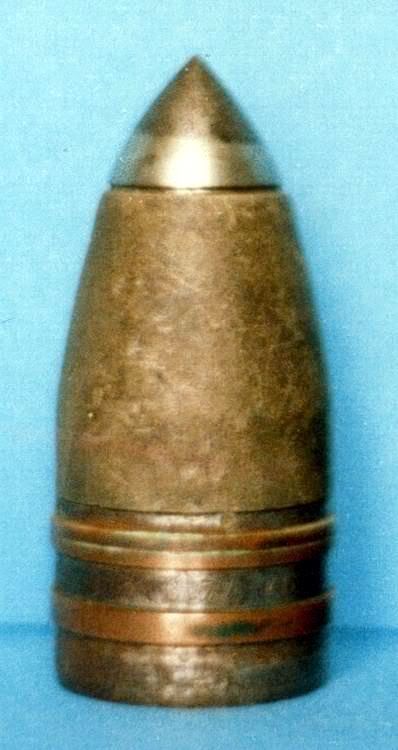




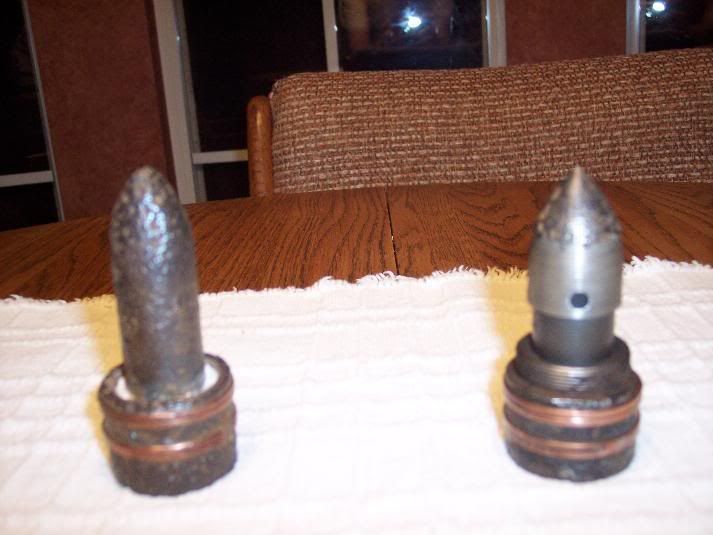
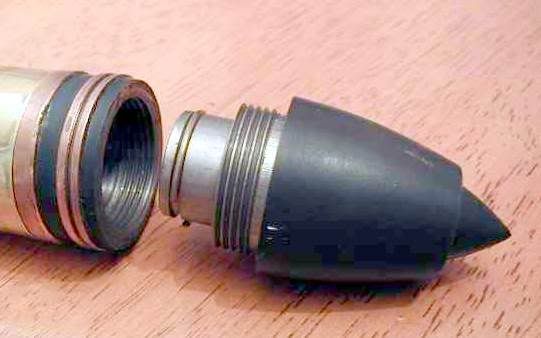

The French utilized a 37mm APCR round, similar to a later German round of the same caliber. Collectors have unfired examples, and examples of the core-slug from these rounds, separated from the aluminum sleeve...possibly by impact with a metallic target.
I don't know who made these French rounds. My understanding has been that it was not Brandt, which apparently concentrated on APDS designs. I however have no photos of known Brandt 37mm APDS.
Was the R40 regularly issued APCR ammunition, or APDS for that matter?
These are photos of collector-examples of French ammo in the 37x94 configuration, as fired by the short 37mm. My understanding is that the long 37mm fired the same projectiles, with a different propellant case of course.
There were (at least) two versions of the French 37mm APCR. The first two photos are of one, the second three photos another. The seventh photo is of two different examples of the tungsten carbide slug...I believe, one from each of the known APCR versions. The slugs might have been re-assembled to bases in which case the parts might or might not be correctly matched, or they could have been found after the war from misses that didn't result in the slug separating from the base, with the aluminum sleeve from each having been removed somewhere along the line. I'm not a collector, so I don't know the exact provenance of what we're seeing. The eighth photo...without the ballistic-and-impact-modifier cap...is of either the second type of French APCR, or a possible third type (noting that it seems to have a different driving-band arrangement), or possibly a mis-identified German round of similar design. The last photo shows the French solid-steel 37x94 AP round, for comparison.








Last edited:
An Alternative Take on British Cruiser Tanks: Update...
What a drama trying to get my hands on some spray undercoat. Just like trying to get hold of models that have mysteriously disappeared off the shelves, there now seems to be a universal shortage of Tamiya fine spray primer. Anyhoo, tracked some down eventually...
The Alt Mk IVA Cruiser Tank (A13 Mk II) is now sporting a nice grey petticoat...



What a drama trying to get my hands on some spray undercoat. Just like trying to get hold of models that have mysteriously disappeared off the shelves, there now seems to be a universal shortage of Tamiya fine spray primer. Anyhoo, tracked some down eventually...
The Alt Mk IVA Cruiser Tank (A13 Mk II) is now sporting a nice grey petticoat...
Last edited:
maybe switch to airbrush applied primer? (i seem to remember you prefer to use rattlecans)An Alternative Take on British Cruiser Tanks: Update...
What a drama trying to get my hands on some spray undercoat. Just like trying to get hold of models that have mysteriously disappeared off the shelves, there now seems to be a Universal shortage of Tamiya fine spray primer. Anyhoo, tracked some down eventually...
The Alt Mk IVA Cruiser Tank (A13 Mk II) now is sporting a nice grey petticoat...
Last edited:
Rattlecans (when available) are just easier and faster. On top of that I still haven’t refitted my garage workshop with my spray booth - so the airbrush is still verboten! 😉maybe switch to airbrush applied primer? (i seem to remember you prefer to use rattlecans)
Praise the rattlecan!Rattlecans (when available) are just easier and faster. On top of that I still haven’t refitted my garage workshop with my spray booth - so the airbrush is still verboten! 😉
I have to wait for good weather to prime outdoors for very similar reasons. Airbrushing just isn't on the table for my living space.
Share:
